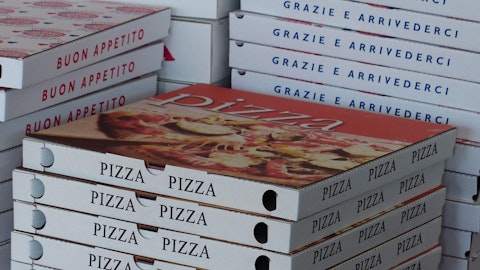Unidentified Analyst: Great. Thanks.
Rob Lynch: Thank you.
Operator: Thank you. One moment for our next question, please. And it comes from the line of Alexander Slagle with Jefferies. Please proceed.
Alexander Slagle : Thanks. Good morning. I wanted to just ask on franchisee health in North America and the volumes are better and margins are down a bit. But where does the average franchisee EBITDA or profit stand now versus 2019? I know we’ve asked on this topic and overall cash returns and investment costs before, and not something you might provide too many details on, but wanted to circle back on it for any additional perspective you can provide these metrics and become more focused for investors, understandably across the industry that gone through such an unusual time in the last few years. And I know you have the Back to BETTER initiatives kind of rolling out to franchisees, expecting a lot of improvements on these metrics. Over time, I just wanted to see if you could circle back on any of those metrics as expected?
Rob Lynch: Yes. I guess what I would share with you is our franchisee situation over the last four years isn’t that dramatically different from corporate situation. So we don’t disclose our franchisee EBITDA, but we do disclose, obviously, the makeup of our company P&L. So, obviously, our margins have come down year-over-year after an amazing 2021 and in front half of 2022 before kind of the inflation really started to take hold. But relative to 2019, our EBITDA margins are up and up pretty significantly. And a flip part of that is a function of our sales are up significantly. In 2019, our average AUVs across the system was about 900,000 and today, we’re up pushing up close to 1.2 million. So, that level of sales and flow-through definitely creates some fixed overhead coverage and definitely create some improved profitability, which has helped us to mitigate some of this increased inflation that we’ve seen on both the commodities and the wages.
And when I tell everybody about this business, is — like if you believe that there is going to be a normalization of commodity costs over the next year, 18 months, then — and you believe that we can hold on to the pricing that we’ve taken, which we’ve seen, an ability to do over the last year since we’ve come out of the pandemic, there’s a ton of upside on operating margin. The commodity inflation that we’ve seen is unprecedented in this business. And record highs for a lot of the input costs. And I fundamentally don’t believe that could stay that way in perpetuity. I believe in efficient markets, I believe that their supply is going catch up to the demand regardless of the macroeconomic environment. So I do believe that there’s a lot of margin expansion at the operating level as we look into the back half of 2023 and beyond.
So I do think that margins right now, although higher than 2019 are a bit compressed relative to what we’re going to see moving forward.
Alexander Slagle : Got it. Thank you.
Operator: Thank you. One moment for our next question, please. And it comes from the line of Eric Gonzalez with KeyBanc. Please proceed.
Eric Gonzalez: Hey, thanks and good morning. It sounds like you’re reiterating that flat to slightly up margin outlook for the year. And I believe you said that you expect a large uptick in G&A in the second quarter due to convention in the fairly large step up for the full year. So perhaps you could help us understand where the other offsets might be from that G&A line? And how much commodity normalization you’re baking into that outlook? Thanks.
Rob Lynch: Yes. I mean, our team has been focused on G&A really since day one this year. And we’ve been very efficient and productive. I don’t think that we’re going to have a significant uptick on our — I think about it on our run rate G&A. The biggest impact of G&A this year is we paid zero bonus last year across our company. We didn’t achieve the targets that we had put in place. Obviously, that was driven by an unforeseen and unprecedented level of cost coming into our P&L and our corporate restaurant ownership has proportionately impacted us relative to our peer group, but we did the responsible thing. And we made sure that we were good stewards of our shareholder value. And so we didn’t pay any bonuses last year. This year, we have baked in return to performance compensation.
So that’s really the big impact on G&A this year. Our actual operating G&A is actually become more efficient. So that’s how we think we’re going to manage through some of these challenges. Obviously, yes, Q2, our first conference. But even the conference, we’re able to come in under our budget and deliver a great conference. So, I’m really excited about our team’s focus, understanding kind of how we need to tighten the belt while the cost structure continues. And I’m confident that we’ll be good stewards of P&L.
Eric Gonzalez: If I could jump back in, the question is really about what are the other parts of P& L understanding that you do have that – the bonuses in the G&A. So, if you could speak to maybe the company margins or other offsets that could get you back to that, keep that top margin flat?
Rob Lynch: Yes, I mean 2% to 4% sales growth is part of it. The other part of it, I think we’ve guided to sequentially improving operating margin. So, those are kind of two of the big drivers. And then our development. We’re going open up across the system between 270 and 310 net new units, so, over 400 units built this year. So between those three drivers, I mean, that’s kind of – those are kind of the drivers of our earnings growth.
Eric Gonzalez: Got it. Thanks.
Operator: Thanks. One moment for our next question, please. And it comes from the line of Lauren Silberman with Credit Suisse. Please proceed.
Lauren Silberman: Thank you very much. Rob, the pizza category broadly seems to be facing some slower trends compared to what we’ve seen elsewhere in QSR. Can you just speak to your view on the pizza category, and whether you’re seeing any changes in customer behavior signs of trade down? And then anything you can share in performance between delivery and carryout would be helpful?
Rob Lynch: Yes. Great question, Lauren. I mean, the pizza category on average over the last 10 years has been relatively slow growth category. During the pandemic, obviously, we, the pizza industry category outperform all of QSR. So, I think as we head in, we’re coming out of that. This is kind of the last quarter where for us where there’s kind of a still a residual, big, COVID impact. People forget that was only a year ago that Omicron was kind of wiping out, a lot of the labor market, the challenges with that, and people were staying home again the last January and February. So, we’re – that positively impacted our category, we’re obviously negatively impacted a lot of the sit down and fast casual. So as you see these positive comps that a lot of the restaurant industry is coming with this quarter, me to reflect on kind of what everybody’s lapping from last quarter.
So now, once we get past all that, we look forward, I mean, we believe that we can continue to grow between 2% and 4%, and that will probably outpace the rate of growth for the category. I think that there’s going to continue to be pressure on 40% to 50% of the category, that’s the mom-and-pop segment. The cost structure is really hard for them to make it work. They don’t have scale to drive the kind of productivity and efficiency that some of the larger groups do and their prices are 40%, 50% higher as a result of that. So, I don’t know how long that can sustain itself. I think that the category in this business is becoming even more digital and IT dependent. But I think that also puts stress on the smaller players that don’t have the resources infrastructure to invest in those capabilities.
So, I think that we’ll be able to continue to take share from some of the smaller players. And then, I think we’ve got a great value proposition moving forward relative to the rest of the industry. Our innovation pipeline continues to fill up with great ideas. And so, despite call it low single digit growth from the category, we’re confident that we’ll be able to continue to deliver between 2% to 4%.
Lauren Silberman: Thank you. Is there anything you can share on what you’re seeing between delivery and carryout?
Rob Lynch: Yes, great question. Sorry, I didn’t get there. We are seeing some shifts into carryout. Our carryout business has always been real robust. I know we haven’t talked about it as much as maybe some of the other players in the industry. But we have a strong carryout business. And as these more challenging economic times and price sensitivity increases, you’re going to see a little bit of a push in the carryout. That doesn’t — that does not necessarily a problem for us. We’re excited about that. Obviously, it can help us maybe with some labor, and some staffing challenges. But it does reduce the ticket to some extent because of the delivery fee that goes with along with the delivery purchase. So, as the model shifts from delivery to carryout, you’re going to have to be able to pick up some savings in the labor side, because you are going to a little bit of a challenge on the revenue side by foregoing those delivery fees.
So – but I think some of our delivery business, organic delivery is supplemented with our continued growth with the third-party aggregators. I know that there’s a lot of talk about their growth rates slowing now, but there’s still grow, outgrow outpacing growth in the core pizza category. So, we’re getting to benefit from that through our investments with them and our partnerships with them. So, our delivery business is probably holistic delivery business has held up a little bit better than maybe some other folks in the category.
Lauren Silberman: Thank you very much. Very helpful.
Rob Lynch: Thanks, Lauren.
Operator: Thank you. One moment for our next question, please. And it comes from the line of Peter Saleh with BTIG. Please proceed.
Peter Saleh: Great. Thanks and good morning. Rob, I just want to come back to the conversation around the commodities. I believe last quarter, when you guys gave the full year outlook, you anticipated commodities maybe modestly deflationary for the full year. I know you ended the first quarter up about 4%. Are you still expecting commodities to be modestly deflationary? It does look like we’ve seen some moderation in some of your input costs. Just if you could give us a little bit more color on that, that would be helpful?
Rob Lynch: Yes. I mean, I think we did expect to see a little bit more deflation already this year, but we’re starting – I mean, it’s sequentially has continued to improve. I mean, it’s just been very volatile. So, we do and our forecast have continued moderation of commodity costs even if Q1 hasn’t fully realized those costs. When you look at what we’re lapping. Q2 of 2022 was by far the highest input cost environment that we operated in. So plus 18% year-over-year. Average cheese price per pound was $2.30. So the markets today are in the dollar call it 80 range. So that’s a big change that we’re seeing in the current environment. But it’s been very volatile, but we do see the full year being modestly deflationary.
Peter Saleh: Great. And then just on unit development, I know you guys reiterated your long-term target. And it does really imply a pretty meaningful step up in development in 2024 and 2025. So, just curious is how quickly can India come on track here and start building units? And so, what other markets do you think you guys need to open to really get to those development targets that you guys laid out this morning? Thanks.




